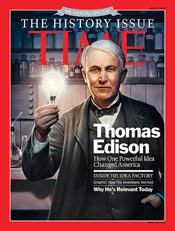Hands down….chemistry was Thomas Edison’s favorite subject. So enamored with its seemingly magical processes, he once said….“I believe that the science of chemistry alone almost proves the existence of an intelligent creator.” Were he here today to see what is being done with chemistry, especially reverse osmosis and its application to desalination, Edison would be very happy indeed.
We think nothing of it every day as we routinely open the sink faucet and draw a glass of water. It is just another aspect of our high standard of living. However, the availability of clean, fresh drinking water is a problem for over one billion people on our planet, a serious impediment to economic development. Sadly in Africa alone, over 50,000 people a year die because they ingested contaminated water.
GE engineers are helping to remedy this problem and have implemented a high-tech desalination plant in Algeria. Using reverse osmosis, a technology stemming directly from GE’s pioneering work in the 1950’s with membrane based water purification technologies, the Hamma Desalination Plant is completely functional, providing millions of gallons of clean, fresh water. Take a look at the recently operational GE Hamma Desalination Plant below, a 53 million gallon per day facility, and enjoy the short video about GE’s work. GE chose reverse osmosis technology because it is energy, cost, and space efficient compared to other desalination methods.
The technological magic of reverse osmosis occurs along the length and cross-section of the long, white tubes pictured here below. This is a typical reverse osmosis stage in a desalination plant. After the salt water enters the tubes, high pressures are applied to it. This forces the fresh water through openings in a special membrane filter that inhibits the passage of dissolved salt and other minerals in the raw sea water—so only fresh water is collected on the other side. The clean water flows out of the center of each tube assembly and is then collected and stored. [see Editor’s Deep Dive below]
The central electric generating stations and distribution systems originally envisioned by Thomas Edison in the 1880s is what today provides the large amounts of electricity needed to operate desalination plants. Now as the world looks toward natural energy sources like the sun and wind, we will no doubt see desalination plants powered by solar panels and maybe even land and offshore wind turbines. Clean water, courtesy of the sun.
Speaking of the sun, an MIT team just announced a design [below] for a solar-powered reverse osmosis desalination system that could be rapidly deployed in crisis situations to produce drinking water; or used in small scale applications like farms, villages and remote hamlets in developing countries.
A prototype built by the Departments of Mechanical and Aeronautics and Astronautics can produce 80 gallons of water a day in a variety of weather conditions. A larger version is estimated to be able to provide about 1,000 gallons of water per day. The MIT team envisions such units delivered in quantity via large transport planes.
Tom Edison would like all this innovation a great deal. He always felt the sun’s power should be tapped; and he believed that…. way back in 1929.
Editor’s Deep Dive {Links & More}
- Click here for a really simple animation of reverse osmosis
- Refer to this more specific animation to see more on the tube-like equipment discussed above
- Check here, if you really want to get into the nitty-gritty of reverse osmosis technology
 “I’d put my money on the sun and solar energy. What a source of power! I hope we don’t have to wait until oil and coal run out before we tackle that.” – Thomas Edison
“I’d put my money on the sun and solar energy. What a source of power! I hope we don’t have to wait until oil and coal run out before we tackle that.” – Thomas Edison




